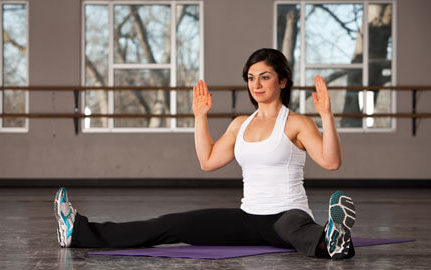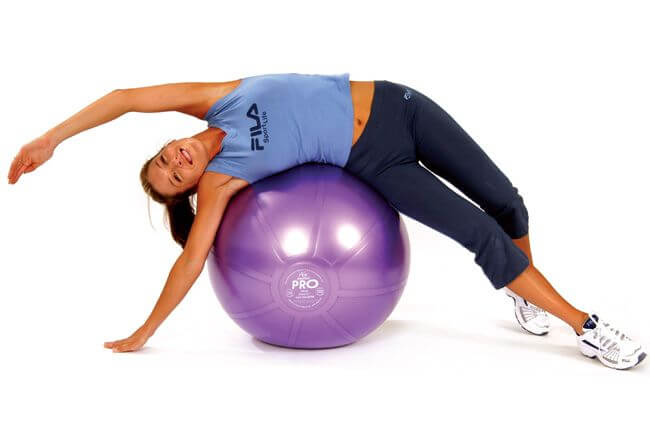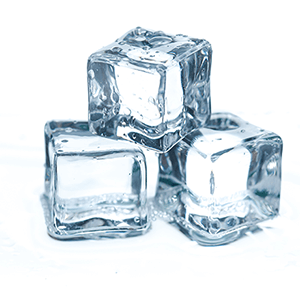Lots of people are craving for toned abs, but to get them in the right shape, we need to do oblique stretches exercises to warm up your abs gradually for best results.
The oblique muscles are part of the abdominal muscle anatomy. The muscles are actually located between the pelvic area up to the ribs.
Wishing for sculpted abs muscle is probably at the top of your priority list if you’re reading this article. But having tight abdominal is an entirely different story. In fact, stretching your abdominal muscles can cause a lot of disruption during your lifting, crushing and other exercises.
The vital muscles in the core body, especially the internal and external obliques, and the rectus abdominis – the six-pack muscles – will actually be an issue for many lifting exercises if neglected over time and allowed to become short and tight.
But what can we actually do to address such a problem? The solution here is simple. Just start now to perform the best oblique stretching exercises.
All core muscles become short and tight easily because of two things. Number one: we seldom stretch our abs every now and then. Second, we sit for long periods of time. Either we drive on our commute to work, or while we work in the office, we sit down. Even at night, we sit a lot. All these wrong behaviors allow the abs muscles to become more and more tight.
We have to realize when we look at people who have problems with these muscles, they have in common they do the same thing, they sit a lot. All of these muscles have connections and origins in the rib cage and then extend downward at the pelvis. They take these two points (rib cage and pelvis) when they are allowed to be tight and bring them closer together, then it becomes a problem.
So, what happens when your rib cage gets close to your pelvis? You can suffer and have a lot of postural issues and it can lead to other things that we think might be a problem but actually can be fixed, if you don’t delay. For example, we see people say to someone who has trouble keeping their back straight, “Oh, he/she has low thoracic extension, and he/she can’t extend his thoracic spine.”
But in reality, they cannot extend the thoracic spine because they are unable to extend the rib cage away from the pelvis due to their very tight abdominal muscles.
Including oblique stretches in your regular workouts will help you maintain an optimal position for your spinal cords and maintain a better posture. In the end, it will keep your body healthy and away from any kind of back problem.
The Best Types of Oblique Stretches
Abdominal Stretches exercises are one of the best ways to loosen your core muscles. The internal and external muscles are on either side of the waist and are the reason for our ability to rotate and flex our torso.
The oblique stretch not only gives flexibility and stability to your spine and ribs, but is also useful for strengthening your back.
Here are some oblique stretching practices that you can add in your daily workout to get a stronger, healthier core. It is suggested that you warm up your body by doing simple cardio exercises (Brisk walking, Running, Swimming or Jumping rope) Before you choose to perform any type of abs stretching exercise. Don’t stretch too far from the point where you start to feel some discomfort.
-
Standing Side Bending with Straight Arms
Not only will this oblique stretch extend your oblique muscles, but it will also help align your front abs and other muscles around your spine. The best part is that you can perform this standing stretch anywhere you want because it requires no equipment other than your body.
Start standing with your feet about shoulder width apart. Interlock your hands and keep your palms facing away from you. Now extend your arms over your head, keeping your elbows straight.
Now without bending your knee, start bending towards your right until you feel some stretch around your waist.
Pause for 15-30 seconds. Now slowly return to your original position and repeat the same for the left side.
-
Lying Bent leg Oblique Stretch
Another way you can lengthen the oblique is by twisting and rotating your torso. It is one of the common oblique stretches that are activated when you lie down and twist your torso. For this, you need to bend your knees at an angle of 90 degrees.
Now put your left foot on top of the right foot and extend your arms so that your upper body is in a T-shape.
Now keeping your shoulders on the floor, slowly move your legs toward the floor to the right until you feel moderate uncomfortable. Pause for 15-30 seconds and then slowly move toward the starting position.
Now put the right foot over the left, and repeat the entire routine on the left side.
-
Seated side Straddle Stretch

This straddle extending exercise allows you to stretch a variety of muscles, including the abdominals, thighs, and hips while improving the flexibility of the core of the spine.
- Sit on the floor with your back straight and your legs wide apart.
- Raise your arms to your sides with elbows bent 90 degrees and fingers pointing to the ceiling, palms facing forward.
- Contract your abdominal muscles and gently bend at the waist to the right side, by moving the right elbow toward the floor as far as possible. To support the balance of the body, make sure not to twist or bend forward. During the exercise you will begin to feel the tension through the oblique stretches.
- Hold this position for 12 to 20 seconds, then return to the starting position.
- Switch to the left side and repeat the steps.
- Repeat 2 to 3 times on each side.
-
Yoga Ball Oblique Stretch

You can get this oblique stretch in the right shape once you start flipping your body above the yoga ball on the right side. When you lie on your side on the ball, your rib cage separates from your pelvis.
Now drop them as far away from each other as possible.
Now, if you twist a bit and lie on your back, you will get a positively extended external oblique. Hold the position for 15 to 30 seconds and repeat the same for the other side.
Benefits of Oblique Stretches
Your core muscles are the main link between your upper and lower body. Whether you play any sport or just do a daily routine, the movements required to do these things either stem from your core or move through it in some way.
It basically doesn’t matter where the movement originates from, it will always pass through the connecting link between your upper and lower body.
Therefore, weak or inflexible core muscles can affect the proper movement of your legs and arms. As a result, the movements you want to perform with your body may not get enough force.
You need your abdominal muscles to be strong and flexible at the same time.
This is why if you are doing any Six Pack Abs workout, it is imperative that you always do oblique stretches. It is an ideal exercise to tone abdominal and has many side benefits as well.
Small, Everyday Moves
From wearing socks to bending over to pick up anything from the floor, from looking around to just staying in a chair – these are some of the most common routines you do on a daily basis and they all depend on your core.
You may not notice all of these movements until you start to feel some back pain and difficulty doing them normally. The simplest tasks rely on your core and oblique stretches to make sure your core stays strong, healthy, and resilient.
Tasks you Perform in Your Job
Even if you’re not on the field of labor, your job still requires you to lift, twist, and stand up sometimes. Even if your job is just to sit in a chair and work on your laptop all day, you will engage your core muscles and cause stress without warning.
If your job requires you to talk on the phone with clients all day, it can lead to stiff and sore on core muscles, especially if you don’t maintain good posture to avoid the daily back pain issue.
Oblique stretches will help you keep all the core muscles in perfect shape so that you can perform all the tasks on the job with ease.
Strong Back
If you are not suffering from lower back pain, trust us, it can disrupt your life in many ways.
Most adults will experience back pain at some point in their lives. Almost every doctor prescribes a basic exercise for core, with some medication to treat it.
So, if you do the abdominal stretching along with some other core muscle exercises, it will help you maintain a strong back and your chances of suffering from back pain will be almost zero.
Sports and other Recreational Activities
Football, cricket, golf, squash, basketball, running, swimming, you name it; Each of these sports requires your back and midsection muscles to be strong and flexible.
Even if you don’t plan to go professional, you still want your back and core muscles to be strong enough that you can enjoy all these sports, and do them right.
Again, oblique stretches can be your core, back and upper abdominal workouts.
Households and Fixing
As you already know, almost every movement you make is connected in some way to your core. So, if you’re going to buy from the grocery, or get your own tools to fix your car, you need a healthy back.
Balance and Stability
Balance and stability are very important in life. If you lack stability and balance, the chances of falling and getting hurt are much higher.
To achieve more stability and balance to your body, you need to work on your core. Oblique stretches will keep your back strong and help you get back on your feet even on the toughest trails.
Perfect Posture
If you want to get the most out of any exercise, the first rule is to maintain perfect posture while doing all the exercises.
The same is the case with life. If you want to perform better in every area of life, you need to maintain perfect posture.
Not only will this help you do things better, and you’ll be able to breathe deeply and easily, but it will also reduce stress on your spine and avoid a herniated disc.
Oblique stretches are known to help achieve an ideal sitting and standing posture.
Symptoms of Tight Obliques
- Pain in the inside epigastric region, and these symptoms are accompanied by heartburn
- Pain near to groin, lower abdomen, and bladder
- Eructation, stomach distension and diarrhea
What are the Other Causes for Tightening and Strain the Abdomen?
The following behavior or activities may trigger the oblique stress and causes pain:
- New hard workout plan for abdominal muscles
- Punching of kickboxing
- Abdominal scar caused by surgery
- Constipation related to stressful
- Severe coughing
- Emotional thinking and stress
- Sitting in an uncomfortable twisted position
Oblique Muscle Strain
The Oblique muscles may be affected by stress from a direct blow to the abdominal area, and excessive strain and use of the muscles by forcefully bending or twisting.
If any type of stress symptom appears, it is essential that you treat it quickly. Because if you don’t respond to stress properly, you can override it with a more serious injury.
How to Fix Oblique Muscle Strain
-
Take a Rest to Recover
Rest is part of the recovery process, so make sure you don’t participate in any nearby sports, until you have regained your muscle strength.
-
Ice
Apply a small amount of ice to the affected area while wrapping it in a towel to reduce pain.

-
Core Exercises
After recovering for several days, you need to start training your core muscles by applying simple core routines to your daily schedule to ensure that you never get injured or strain your abdominal muscles again.
-
Oblique Stretches
Performing the stretching exercises mentioned in this article after recovery, will help prevent being affected by such a strain.
FAQ
What is the benefit of side stretching exercises?
The benefits of lateral stretches provide great value by stretching the muscles of the abdomen, hips and thighs, while increasing the flexibility of the core of the spine. In addition, the lateral bends grant stretch for muscle between the ribs (Intercostal muscles).
What is an Internal Oblique?
The internal oblique is the part of the abdominal muscle located under the external abdominal oblique.
This muscle plays a role in supporting the abdominal wall, assists in forced breathing, helps balance high pressure in the abdominal region, and rotates and flexes the torso with the help of other surrounding muscles.
Where do the Oblique Muscles Attach?
Oblique attached with ribs. The external oblique extends diagonally down to each side and is attached to several different locations in the upper and outer part of the posterior hip bone.
How to Build your Oblique Muscles?
Since the oblique are part of the abdominal muscles, So, the Six Abs Pack Muscle workouts will tone the muscles and strengthen the shape of the abdominal muscles.
